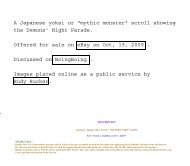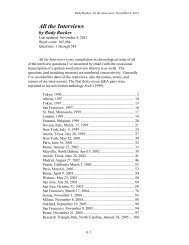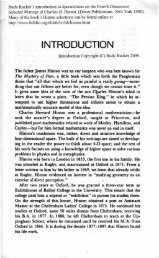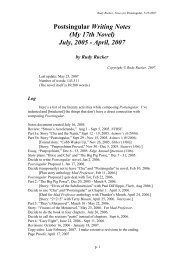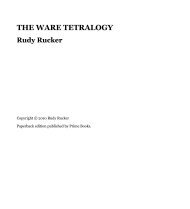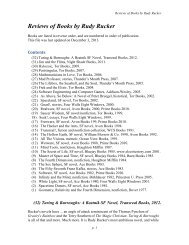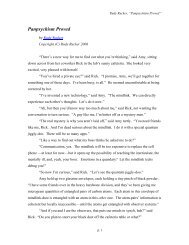Notes for the Lifebox, the Seashell, and the Soul - Rudy Rucker
Notes for the Lifebox, the Seashell, and the Soul - Rudy Rucker
Notes for the Lifebox, the Seashell, and the Soul - Rudy Rucker
Create successful ePaper yourself
Turn your PDF publications into a flip-book with our unique Google optimized e-Paper software.
<strong>Notes</strong> <strong>for</strong> The <strong>Lifebox</strong>, <strong>the</strong> <strong>Seashell</strong>, <strong>and</strong> <strong>the</strong> <strong>Soul</strong>, by <strong>Rudy</strong> <strong>Rucker</strong><br />
how easy it would be to build a virtual computer out of a StarWars pattern, it is reasonable to<br />
call it class four. It’s also my impression that if you click one of <strong>the</strong> dead pixels into <strong>the</strong><br />
firing state, <strong>the</strong> effects may propagate outwards to an arbitrarily large degree. It could be that<br />
<strong>the</strong> cascade sizes obey a histogram power law, in which case StarWars would serve as a class<br />
four rule which supports inverse power law statistics.<br />
The StarWars image was made with Mirek Wójtowicz’s downloadable Windows<br />
executable Mirek’s Cellebration, which can be obtained from his http://www.mirekw.com/ .<br />
Note that Mirek has a Java version of his program online as well, although <strong>the</strong> st<strong>and</strong>alone<br />
executable seems to run a bit faster.<br />
Mirek discovered <strong>the</strong> StarWars rule. It has 4 states which we think of as being <strong>the</strong><br />
ready state 0, <strong>the</strong> firing state 1, <strong>and</strong> <strong>the</strong> 2 resting states 2 <strong>and</strong> 3. The update rule is as follows.<br />
If a cell in <strong>the</strong> ready state 0 has exactly two firing neighbors it goes to <strong>the</strong> firing state<br />
1.<br />
If a cell in <strong>the</strong> firing state 1 has three, four or five firing neighbors <strong>the</strong>n it stays in<br />
state 2. O<strong>the</strong>rwise it goes to <strong>the</strong> resting state 2.<br />
A cell in <strong>the</strong> resting state 2 goes to <strong>the</strong> resting state 3.<br />
A cell in <strong>the</strong> resting state 3 goes to <strong>the</strong> ready state 0.<br />
Examples of News Stories<br />
Nearly everyone knows about <strong>the</strong> big ones. The invention of automobiles. The<br />
Second World War. The fall of <strong>the</strong> Berlin Wall. The dot com bubble. Harry Potter. 9/11.<br />
Life is Hard at Every Level<br />
Returning once again to my concern about being a mid-list non-best-selling author ⎯<br />
here I am stuck out on <strong>the</strong> fat-but-not-all-that-fat tail of <strong>the</strong> gravy train.<br />
Criticality means that at least things are boiling at every level. So it’s never going to<br />
be dull. In fact it’s not easier to send your stories to very low-circulation magazines or take<br />
jobs you’re over-qualified <strong>for</strong>. There’s just as much hassle at every scale where you’re<br />
competent.<br />
Power Law <strong>Notes</strong><br />
Natural phenomena often obey a certain scaling property called a power-law<br />
distribution. To set <strong>the</strong> stage, we first break some phenomenon into components of various<br />
sizes, <strong>and</strong> <strong>the</strong>n <strong>for</strong> each size level, we evaluate how much <strong>the</strong> components of this size<br />
contribute to <strong>the</strong> phenomenon as a whole. In a power-law distribution, <strong>the</strong>re is some<br />
characteristic exponent D such that <strong>the</strong> relative contribution of pieces of a given size R is<br />
proportional to <strong>the</strong> reciprocal of R raised to <strong>the</strong> power D.<br />
Intensity of contribution from <strong>the</strong> pieces of a given size R ~ 1 / R D<br />
More <strong>for</strong>mally, <strong>the</strong>re will an exponent D <strong>and</strong> some constant factor C such that if P(R)<br />
is <strong>the</strong> intensity or strength of <strong>the</strong> contribution from <strong>the</strong> pieces of size R, <strong>the</strong>n<br />
P(R) = C / R D<br />
Let me illustrate with a simple example, <strong>the</strong> sizes of rocks on a mountainside, which<br />
obey a power-law distribution with D = 1. To begin with, we’ll measure <strong>the</strong> sizes of <strong>the</strong><br />
p. 86




